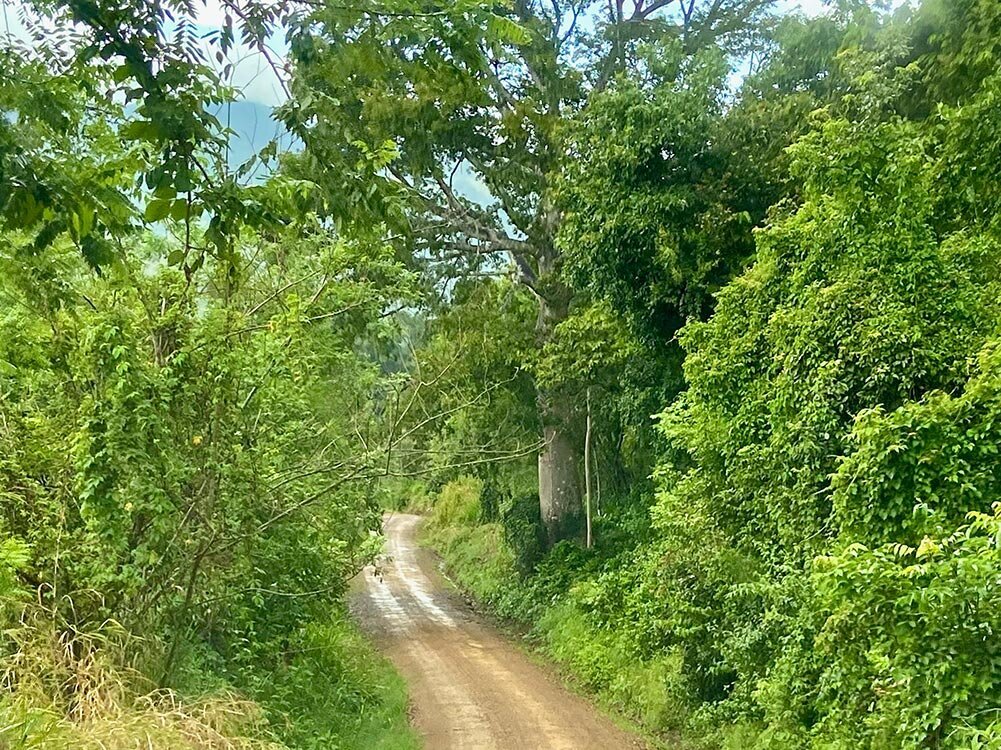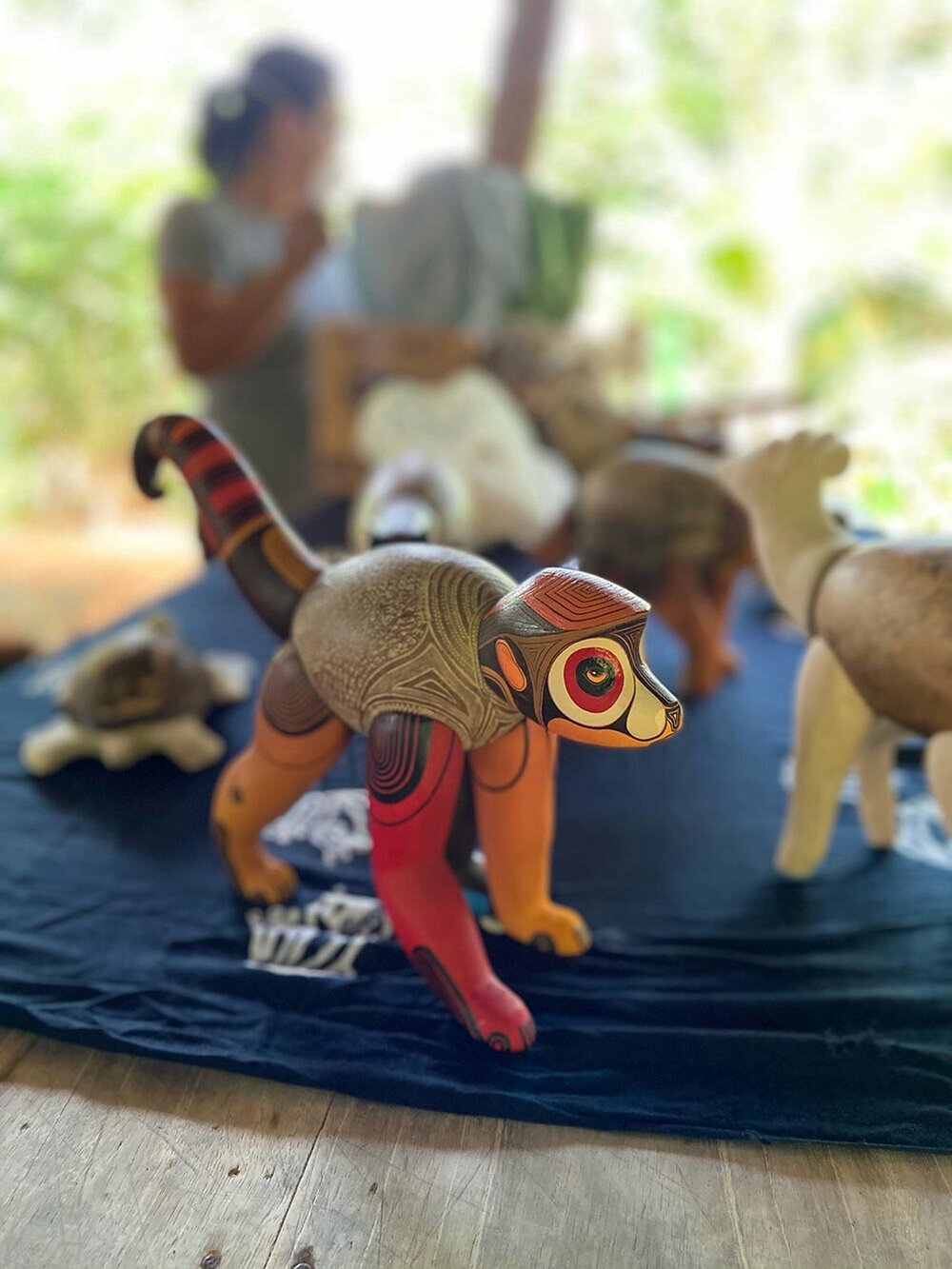In search of the Boruca indigenous tribes
told by Chantelle & Simon (owners of Golfo Dulce Retreat)
Pristine nature is unrivalled in Golfo Dulce. But here in southern Costa Rica, ancient indigenous tradition, often overlooked by visitors, is just as fascinating.
We cross the iron bridge spanning over Costa Rica’s longest river, the mighty Rio Grande de Terraba, its muddy waters hastily rushing towards the Pacific after a few days of heavy rain.
In our five years of living in the Costa Rican rainforest, the bridge has taken a real significance. Once we cross it on our way back to ‘civilisation’, we’ve left behind the Osa, that unimaginable stretch of land home to two of Costa Rica most biodiverse national parks - Corcovado and Piedras Blancas - and the pristine waters of Golfo Dulce. The tranquil waters of the gulf harbour an array of marine species, including dolphins, juvenile hammerhead sharks and migratory humpback whales to mention a few... and along its shores, far away from it all, is also our home, Golfo Dulce Retreat.
The valley of Rio Grande de Terraba
The dirt road to the Boruca settlements
This time though, instead of driving up the Costanera through the tourist spots of Dominical, Quepos and Jaco, we take a turn to the right. We drive along what makes part of the original Pan-American Highway, the 19,000 mile long road which stretches across the American continent from Alaska in the north all the way down to Argentina. Coasting the brown waters of the Rio Grande, sheer mountains rise on our left, fallen boulders lay ominously along the road and all cellular network bars on our iPhones quickly disappear. A sign with peeling paint which says “BORUCA 8km” suddenly appears and we take a sharp left onto a dirt road.
The valleys and mountains along the Rio Grande are the home of the Borucas and Terrábas, indigenous people whose ancestors occupied most of the eastern Pacific coast of modern Costa Rica at the time of the arrival of the conquistadores. Just like in the rest of the American continent, the story of these native people after the 1500s and to this day has been one of subjugation, persecution, denial of traditional beliefs and systemic wiping out of their ancient customs and language. In Costa Rica, it was only as recently as 1993 that these tribes were given some basic rights to their ancestral lands however they still lack representation at local or national government level.
When two elder villagers of the 2,000 strong Boruca community passed away a few years ago, most knowledge of their spoken language - the Bronka language - also disappeared with them. It was not until a recent revival of Boruca customs that the Bronka language is now taught in the local school. Most Borucas, inevitably, only speak Spanish, with only a few Bronka words mixed into conversations.
The three million tourists who visit Costa Rica annually are lured to this country mainly by its untamed nature and beautiful beaches. This is certainly a nature-lover paradise - the Osa Peninsula, especially, is one of the most biodiverse places on earth, rivalled not even by the Amazon forest. A few others come for the surfing - with the second longest left wave in the world, the south of Costa Rica boasts another reason for being the perfect holiday destination. But very few people come to explore the local indigenous culture, some of which dates back thousands of years. Ironically, however, most visitors to this country will indulge in last minute souvenir shopping at the airport and purchase balsa masks to take back to their country, unaware of the rich indigenous tradition of Costa Rica.
Detail of a face ‘hidden’ in a Boruca mask
A beautiful example of a modern ‘ecological’ Boruca mask
A detail of a Boruca mask
Behind those colourful masks is the skilful carving of the Borucas, passed on through generations. Their original masks, often unpainted and mainly depicting devil faces, are still used nowadays during the festivity of “El Juego de Los Diablitos”, a three-day ceremony which takes place at the beginning of the year. This dance, or baile, is an allegorical representation of the fight of the original Borucas (who would need to hide their identities behind devil masks) against the bull (a symbol of the Spanish conquistadores).
The Boruca Bull mask symbolises the Spanish conquistadores
Old photographs of a ‘El Juego de los Diablitos’ Boruca ceremony
The masks sold in souvenir shops all over the country have now taken the form of intricate, multi-coloured and richly carved animal and plant depictions, which appeal to tourists, but are certainly far removed from the authentic and traditional meaning of the balsa masks.
We climb up the ridge on our 4x4 to reach the settlements of the Boruca village, dispersed amongst tropical vegetation. Fast growing balsa trees, which provide the raw material for the masks, are dotted everywhere. A small church, painted deep blue with a large cross on its modest steeple, contrasts the white dusty plaza at its front. It’s ironic that here is where the “bull” - the Spanish invaders who brought Christianity to these lands - is symbolically killed during the annual festivities.
We are welcomed warmly by Doña Loli into the back of her simple one-storey house. A muddy motorbike is kept there, tucked under an old sheet, maybe to protect it from the unforgiving heat and rain typical of this region of Costa Rica; soon, a couple of chairs make their appearance, with upholstered cushions, which, with a faint hint of past embroidery, have now faded into a blotchy grey. A few kittens spring up from a bush, scruffy, skinny and playful.
A chair for visitors to a Boruca house
Little kitten appears from nowhere
Doña Loli and her son Paco are both very skilful artists: she carves beautiful patterns on the shells of the jicaro fruit and chunks of soft balsa wood, and Paco brings her carvings to life by adding exquisite colours and shading. Without seeking pity and with a deep sense of determination, she recounts her earlier life, a time when she had to take care of her disabled daughter - now gone - and started learning her ancestral skills, typically only taught to Boruca men.
One after the other, she brings out her beautiful handicrafts, while her elderly mum stands at the door eager to partake in the sudden rush of activities. Out come turtles made of balsa and jicaro shell, depicting intriguing marine life, maybe reminiscent of a long time gone when the Borucas living in coastal regions used mollusks to obtain a purple dye for their textiles. Then is the turn of small sculptures of ocelots, monkeys and ant-eaters, whose abstract patterns, meticulously carved on their bodies, perfectly match the stark colours used by her son for their legs and tails. And more, and more. None look like cheap souvenirs, instead each is a unique object made with attention, passion and ancient traditions: art pieces which would proudly sit in a small art gallery in New York along with other pieces of equally talented artists.
A beautifully carved and painted handicraft
Boruca artists Doña Loli and her son Paco
Back at Golfo Dulce Retreat, our home in the jungle, we stare with delight at the precious pieces of art brought back from our visit, including an original mask of a jaguar, the king of our magnificent rainforest, used at a ceremony in years gone by. It feels no less than a privilege to have these handicrafts with us, made by the ancient and rightful owners of much of these lands.
Crossing the Rio Grande de Terraba on our way back to the Osa
An original Boruca mask used in El Juego de los Diablitos













